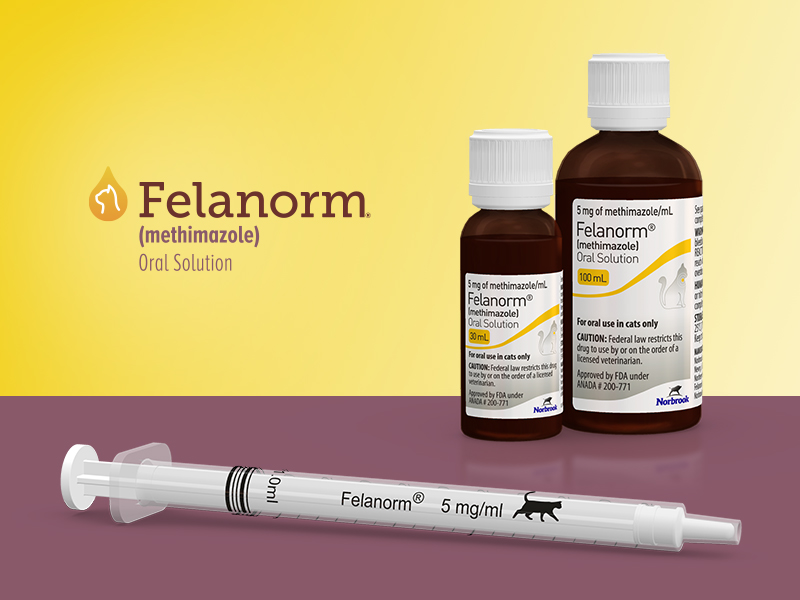Hyperthyroidism in Cats
Hyperthyroidism, the overproduction of thyroid hormone by the thyroid glands, is one of the most commonly diagnosed endocrine diseases in cats. It is estimated that approximately 10% of cats over 10 years of age have this condition.1,2 While typically identified in older cats, it isn’t limited to this group.
Some of the more common symptoms associated with this disease include weight loss, increased heart rate, increased appetite, diarrhea, vomiting, poor hair coat and behavioral changes such as hyperactivity, irritability or aggression. Less obvious to the cat owner initially are secondary signs such as hypertension (high blood pressure), increased drinking and urination (often associated with decreased kidney function), and heart disease that can be associated with progression of the disease. These latter signs are often detected through a thorough physical examination coupled with blood and urine evaluation by a veterinarian.
Hyperthyroidism results from a functional tumor in one or both of the thyroid glands, which are located in the neck along the trachea. The vast majority of these tumors are benign (adenomas), although malignant versions (adenocarcinomas) do occur in about 1–3% of diagnosed cases.2 Left untreated, hyperthyroidism can lead to life-threatening problems for the cat. If adequately treated and regularly monitored, however, most cats with hyperthyroidism can enjoy a significantly improved quality of life and life expectancy.
What Is Methimazole Used for in Cats?
While there are other feline hyperthyroidism treatment options, including radioactive iodine therapy, surgery and a prescription diet (a food that has reduced iodine levels), methimazole (also known as thiamazole) is the only oral drug approved for the medical management of hyperthyroidism in cats in the U.S. Most cats undergoing medical management of hyperthyroidism in the U.S. receive methimazole medication.1 Once a diagnosis of hyperthyroidism is made, the veterinarian can provide guidance regarding which of the treatment options is best for the cat.
What Formulations of Methimazole Are Available to Treat Hyperthyroidism in Cats?
Methimazole Oral Formulations for Cats
Oral methimazole is currently available as FDA-approved coated tablets, human generic tablets and several compounded oral formulations. Norbrook’s Felanorm® (methimazole) Oral Solution was recently approved for the treatment of hyperthyroidism in cats and is expected to provide a dramatic improvement in the treatment experience for both cats and cat owners.
As most cat owners can attest, “pilling” cats can be quite challenging — few cats taking methimazole oral tablets do so willingly. As a result, the human-animal bond is frequently threatened by the pilling experience.
Methimazole Transdermal Gel for Cats
For those cats where oral medication is challenging, transdermal methimazole gel is available from compounding pharmacies. The gel is applied to the inner surface of the cat’s ear, where it is absorbed into the bloodstream.
Unfortunately, transdermal gels often have variable absorption and frequently require elevated dosing compared to oral formulations. Additionally, transdermal methimazole treatment poses a potential health and safety risk to family members and other pets in the household due to exposure to the cat’s topical medication.
†What Is Felanorm® (methimazole) Oral Solution?

Felanorm is the first FDA-approved oral methimazole solution for the treatment of feline hyperthyroidism. Norbrook introduced a methimazole oral solution to the world in 2016 and has sold over 100 million doses in the U.K. since that time.3 Felanorm is a honey-flavored oral solution that was awarded the “Easy-to-Give” designation by the International Society of Feline Medicine (ISFM) due to its ease of administration.4 Because Felanorm can dramatically reduce the struggles associated with medicating cats, “pilling” may no longer be necessary in many cases and transdermal methimazole therapy should be needed far less frequently.
Felanorm is available in 30 and 100 mL bottles and has a two-year expiration date from the date of manufacture. It can be stored at controlled room temperature and requires no refrigeration.
Transitioning Cats to Felanorm® from Other Oral Formulations of Methimazole
If the cat is well-managed on its current oral formulation:
● Discontinue the current product and start treatment with Felanorm at the next scheduled dose using the current dosing regimen.
● Total T4 (TT4) should be re-checked in 3 weeks to see if dose adjustment is needed.
If the cat is not well-managed on its current regimen:
● Discontinue the current product and start treatment with Felanorm at the next scheduled dose using the label-recommended dose.
● TT4 should be re-checked in 3 weeks to see if dose adjustment is needed.
Transitioning Cats to Felanorm® from Transdermal Gel Formulations of Methimazole
Because transdermal gels often have variable absorption and frequently require elevated dosing compared to oral formulations, a “washout” period (no medication is administered) is recommended for 24 to 48 hours to ensure that any residual methimazole is metabolized prior to starting Felanorm. The Felanorm dose will be dependent on whether the owner was compliant in administration and whether the cat’s thyroid level was controlled in the normal range.
If the cat is euthyroid:
● After the washout period, start the cat's daily dose for the Felanorm oral solution at half of the previous daily transdermal dose. The resulting daily dose should be divided and administered twice daily.
● TT4 level should be evaluated in 3 weeks (sooner if clinical signs warrant) to determine if dose adjustments are indicated.
If the cat’s thyroid gland status is unknown or if the owners were not compliant with dosing:
● After the washout period, treat the cat as if newly diagnosed by establishing a baseline TT4 level and beginning at label-recommended dose and frequency.
● Recheck TT4 level in 3 weeks (sooner if clinical signs warrant) to determine if dose adjustments are indicated.
Monitoring Recommendations for Cats Treated with Felanorm®
● A CBC, blood chemistry panel and total TT4 should be evaluated prior to initiating treatment and monitored after 3 weeks and 6 weeks of treatment. The goal is to maintain the cat’s TT4 levels in the middle of the normal range. The recheck TT4 level can be drawn at any time during the day.
● The Felanorm dose should be titrated to effect based on individual serum total TT4 levels and clinical response. The syringe included in the Felanorm package allows for fine titration of the methimazole dose.
● Thereafter, unless clinical signs dictate, blood work should be monitored every 3 months and the dose adjusted as indicated.
● Cats receiving doses greater than 10 mg per day should be monitored more frequently. For cases requiring doses of 10 mg/day (or higher), the client should be carefully questioned about compliance and the ability to administer the prescribed dose, and the presence of thyroid adenocarcinoma should be considered.
● Cats with other underlying diseases should also be tested more frequently.
Managing Hyperthyroid Cats With Comorbidities
Diabetes Mellitus
Diabetes is not a contraindication for the treatment of hyperthyroidism in cats. Both diseases should be managed. Because protein turnover is increased in feline hyperthyroidism, the half-life of fructosamine may be reduced.5 As a result, fructosamine levels should not be relied on to assess glucose control until the cat’s thyroid hormone and protein levels are stabilized in the normal range. These cases will require very close monitoring and adjustment of treatments for each condition.
Chronic Kidney Disease
While the labeling of all currently FDA-approved methimazole products states that use in cats with renal disease is contraindicated, treatment of hyperthyroid cats is widely recommended by most veterinary experts regardless of the presence of concurrent disease (including pre-existing chronic kidney disease).
The AAFP Guidelines for the Management of Feline Hyperthyroidism6 provide detailed guidance for managing these comorbidities. It is critical to carefully monitor these patients to maintain thyroid levels in the middle of the normal range and to avoid both hypothyroidism and hyperthyroidism.1 Both conditions will need to be monitored and managed carefully as each influences treatment of the other.
IMPORTANT SAFETY INFORMATION
Side Effects of Methimazole in Cats
CAUTION: As with all drugs, side effects may occur. The most commonly reported side effects are anorexia, vomiting, head/facial pruritus or edema, depression/lethargy, weight loss, anemia, elevated liver enzymes, skin lesions, elevated BUN, diarrhea and thrombocytopenia. Felanorm Oral Solution is not for use in pregnant or lactating queens, or cats with renal, hepatic or hematological disorders. In some reported cases, the patients recovered after adverse signs were recognized, the drug was withdrawn and veterinary care was applied. In some cases, death (or euthanasia) has been reported as an outcome of the adverse reactions listed above. Methimazole has anti-vitamin K activity and may induce bleeding diathesis without evidence of thrombocytopenia. Please refer to the product insert for a complete list of warnings, potential side effects and prescribing information associated with Felanorm.
To report suspected adverse drug events, for technical assistance or to obtain a copy of the Safety Data Sheet (SDS), contact Norbrook at 1-866-591-5777. For additional information about adverse drug experience reporting for animal drugs, contact FDA at 1-888-FDA-VETS or http://www.fda.gov/reportanimalae.
US Patent Numbers: 10,045,967, US 11,123,327 and US 11,738,005
†Please refer to Felanorm product insert for complete prescribing and safety information.
References
1. Carney HC, Ward CR, Bailey SJ, et al. 2016 AAFP Guidelines for the Management of Feline Hyperthyroidism. J Feline Med Surg 2016;18(5):400–416.
2. Peterson M. Hyperthyroidism in cats: what’s causing this epidemic of thyroid disease and can we prevent it? J Feline Med Surg 2012;14(11):804–818.
3. Kynetec Sales Data, U.K. (based on standard 2.5 mg dose).
4. ISFM Easy-to-Give award 2017 (note: Thyronorm® is the U.K. version of Felanorm; exact same formulation).
5. Reusch CE, Tomsa K. Serum fructosamine concentration in cats with overt hyperthyroidism. J Am Vet Med Assoc. 1999 Nov 1;215(9):1297–300. PMID: 10553441.
6. 2016 AAFP Guidelines for the Management of Feline Hyperthyroidism.
© 2024 Norbrook Laboratories Limited. The Norbrook logo and Felanorm are registered trademarks of Norbrook Laboratories Limited. 771-24-196






